Taking Stock: report on progress towards a cyber resilient Scotland
Our vision is for Scotland to be a cyber resilient nation. This report reviews strategic activities since 2015 to improve the cyber resilience of Scotland’s citizens and our public, private and third sectors, while also setting out priorities for the future.
Section 4: Progress and Priorities going forward
People’s cyber resilience
Improved awareness and behaviours
The Scottish Government, working with its partners, oversees a Scotland-wide engagement programme aimed at increasing people’s awareness of cyber threats and encouraging better cyber resilient behaviours. This supports our strategic outcome: People recognise the cyber risks and are well prepared to manage them.
Results from the Scottish Household Survey suggest there has been improvement in people’s online behaviours. Figure 1 shows that between 2015 and 2019, the average percentage of adults who said they were confident in using the internet increased from 86% to 88%. The average percentage who said they adopt cyber security measures online increased from 53% to 57%.[7]
Data captured from 2020 onwards is not directly comparable with previous years due to the change in survey methods (from face-to-face to telephone based). The 2021 and 2020 data points are therefore separated from the earlier data points in Figure 1. The results from the 2021 telephone survey showed that on average 92% were confident Internet users, and 70% adopted security measures.
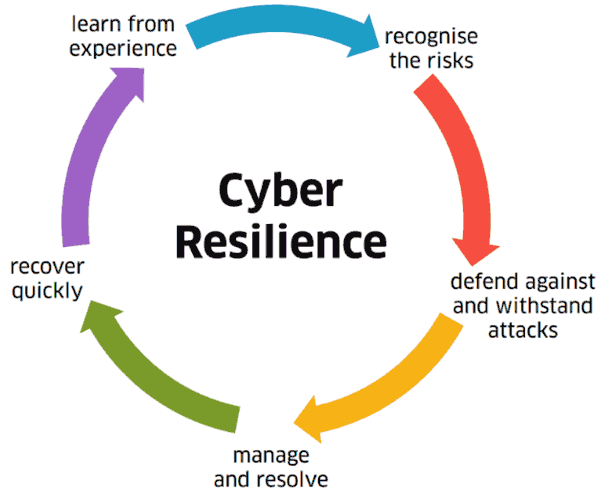
Source: Scottish Household Survey
Between 2020 and 2021:
- The percentage of people who said they avoided opening emails or attachments from unknown people increased from 78% to 85%.
- The percentage of people who said they set complex passwords increased from 58% to 66%.
- The percentage of people who said they backed-up important information increased from 58% to 64%.
Reaching diverse groups
The Scottish Government recognises that many people face barriers to communication or require information to be presented in alternative and accessible formats. The Strategic Framework notes that accessibility of cyber advice is vital to ensure that everyone is included, is cyber aware and able to protect themselves online.
The Scottish Government funded the national disabled learners’ charity, Lead Scotland, to adapt the NCSC’s Cyber Aware guidance into 16 accessible formats, including British Sign Language, Easy Read (for people with learning difficulties) and several community languages. Lead Scotland further disseminated this advice through a series of training sessions for adults. In the feedback, 100% of the participants noted an increase in their confidence levels in improving their own online security.
Cyber resilient behaviour in young people
The 2021 Young People in Scotland Survey included questions about online security. The findings suggest that we continue to face some challenges.
Despite 83% of young people saying they were either ‘very’ or ‘fairly confident’ that their online accounts or devices were safe and secure, only 7% stated that they ‘never’ use the same passwords across different accounts and devices, with 18% stating that they ‘always’ reuse them. In addition, only 10% stated that they ‘always’ follow the NCSC’s recommendation of using passwords made up of three or more random words. Just one third said they would ‘definitely’ know where to get help if their online account or device was hacked.
The Scottish Government has funded Young Scot to run an ongoing cyber awareness campaign dedicated to address this gap. Since 2015, this online campaign received 85,462 clicks and 443,113 engagements. In autumn 2022, Young Scot reported that 51% of the young people they surveyed were ‘likely’ or ‘very likely’ to secure their accounts by updating their passwords or use a password manager after seeing Young Scot DigiKnow social media adverts.
Cyber resilient behaviour in older people
In 2022 and 2023, the CyberScotland Partnership ran a TV advert campaign for older people, aiming to raise their awareness of basic cyber hygiene. The three DigiKen adverts encouraged people to use passwords with three random words, use two-factor authentication and to update their software and devices regularly.
Credit: Heehaw Ltd
Figure 2 shows that older people who had seen the DigiKen adverts reported higher awareness of the cyber security advice given than those who had not seen the adverts. For example, 78% of people who had seen the DigiKen advert were aware of the advice to use three random words in their passwords, compared with 53% of people who had not seen the advert. This suggests that advertising campaigns can be an effective way of educating the public.
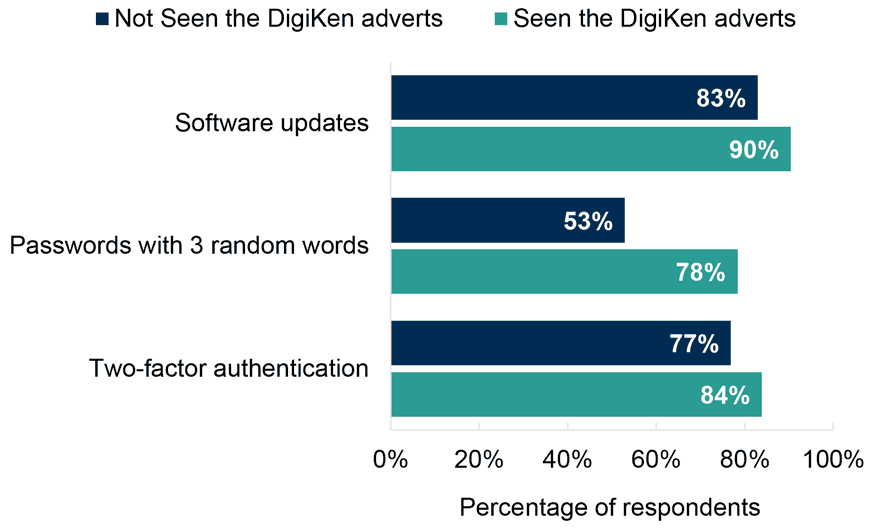
Source: ScotPulse
However, as with the data regarding young people’s behaviour, the ScotPulse survey shows a gap between older people’s awareness of the advice and their actual online security habits. For instance, only 26% of those aged seventy and over said they use three random words for passwords.
Looking ahead: priorities for people’s cyber resilience
We recognise the wide-ranging impact that digital technologies continue to have on our lives and the importance of a whole of society approach to building cyber resilience. We will be taking further actions in the following areas:
- Increasing the reach and adoption of advice, guidance and support to improve online behaviours of the general public and particularly those who are vulnerable.
- Building the capabilities of the CyberScotland Partnership to ensure wide reach of relevant guidance and support.
The cyber resilience maturity of Scotland’s public sector
SG CRU oversees a significant public sector work programme and engages every public sector body in Scotland to support them increase their cyber maturity and resilience. It shares guidance to Scottish public sector bodies for supply chain cyber security (e.g. Cyber Security: guidance for public sector buyers) and to better manage cyber incidents (e.g. Cyber capability toolkit). SG CRU also provides regular, and when required, rapidly arranged engagement through sector-specific networks, workshops and early threat warning notifications. It works with the Digital Office to support local authorities to improve their cyber security. The SC3 fosters collaboration between partners including HEFESTIS (further and higher education), Police Scotland and NHS National Services Scotland (health).
The Scottish Government also coordinates the implementation of the Network and Information Systems Regulations (NIS) to ensure that lessons and good practice from the highly regulated Drinking Water and Health Sectors are shared with the wider public sector.
Assessing the maturity of the Public Sector
The SG CRU conducted a series of surveys of Scottish public sector bodies in 2018, 2019, 2021, and 2023. This report includes evidence from the latest public sector survey and, where relevant, compares it with previous years.
The survey asks public bodies about their cyber security assurance measures in order to gauge their preparedness to manage cyber threats including incident response plans and adoption of Active Cyber Defence (ACD) Measures. ACD refers to the group of cybersecurity services and technologies, introduced by the NCSC, to help organisations deal with the most common but least sophisticated types of cyber threats. The number of organisations that respond varies from one survey to the next and the response rate is never 100%. This creates a limitation in comparing survey results across time, since the results can be affected by which organisations respond to a given survey. However, it does give us a general sense of cyber maturity across the public sector and will help with targeting future interventions and support to specific organisations or subsectors.
The Public Sector Cyber Resilience Framework
The Public Sector Cyber Resilience Framework (PSCRF) provides a consistent structure for Scottish public sector organisations to:
- assess their cyber resilience arrangements
- identify areas of strength and weakness
- gain reasonable confidence that they are adhering to minimum cyber resilience requirements
- make informed decisions on how to achieve higher levels of cyber resilience on a risk-based and proportional basis.
The PSCRF brings together the technical controls from various standards and certifications – including Cyber Essentials, ISO27001, PSN and NIS Cyber Assessment Framework – to form a single framework for the public sector. This allows organisations to compare their cyber maturity with other organisations, regardless of the specific standards an organisation aligns with.
PSCRF adoption is surveyed every year, gauging current levels of capability across a range of areas including cyber assurance, incident response planning and staff training.
Increased incident response planning and exercising
Incident response planning is critical to any organisation’s cyber resilience. The SG CRU has provided guidance and training to organisations to develop their incident response arrangements. To embed exercising into organisations’ operations SG contracted the Cyber and Fraud Centre Scotland (previously known as the Scottish Business Resilience Centre) to deliver facilitated sessions of Exercise in a Box (EiB) to help public sector bodies practise their response to cyber attack scenarios. Exercise in a Box provides allows organisations to take their first steps into cyber exercising before progressing to more complex and bespoke testing of their plans.
Figure 3 indicates the number of Scottish public sector organisations that participated in EiB sessions over each delivery phase. Fifty-five organisations used EiB during phase 1.0 (2020-21) and 73 used it in phase 2.0 (2021-22). 138 organisations used this tool in phase 3.0 (August 2022-March 2023), suggesting its usage has increased over time.
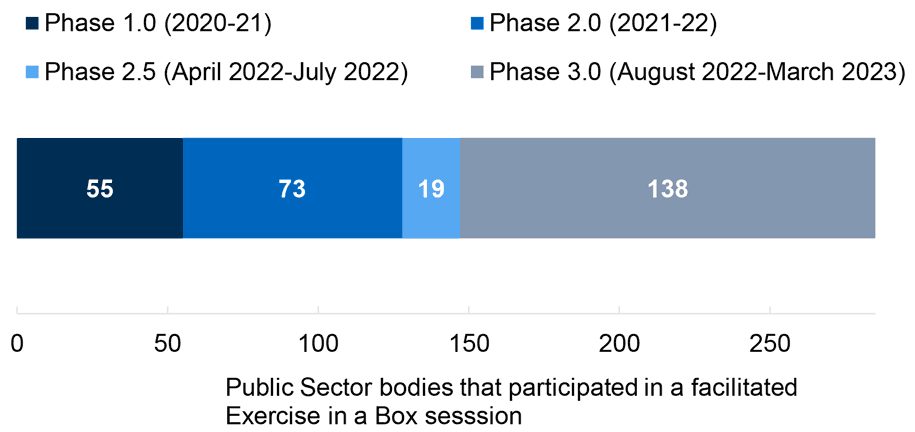
Source: Cyber and Fraud Centre Scotland
There has also been an increase in public sector bodies preparing their incident response plans. Figure 4 shows that the percentage of public sector bodies with an incident response plan in place has more than doubled in 5 years (from 41% in 2018 to 87% in 2023).
However, there is not as much traction with organisations testing their incident response plans and in 2023 only 48% reported that they regularly test their plans.
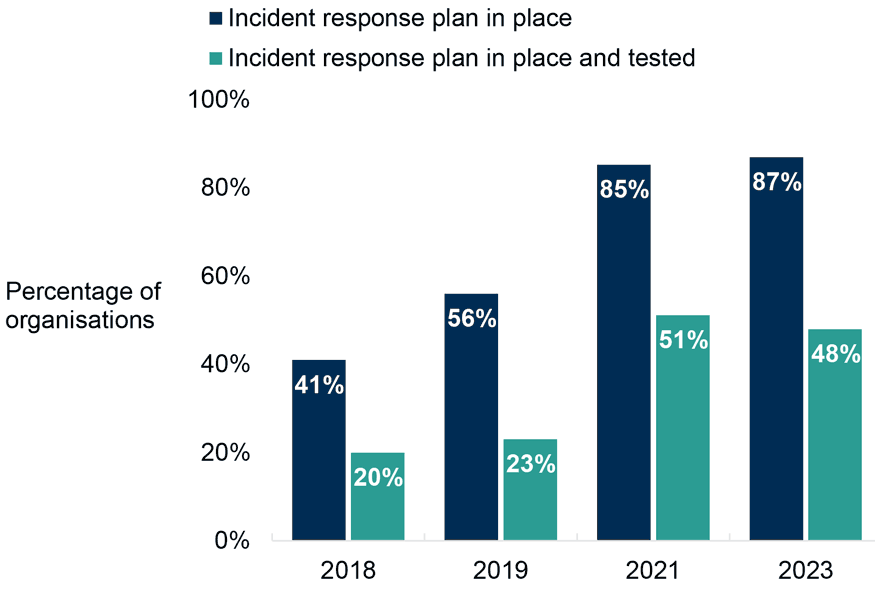
Source: SG CRU
The SG CRU continues to roll out EiB awareness raising sessions and expects a further increase in public sector bodies developing and testing their own incident response plans in the near future.
National exercising underway
As part of the Strategy the Scottish Government is committed to delivering at least one national cyber exercise per year. The national exercise is designed to test inter-agency coordination and linkages with the wider UK cyber incident response arrangements.
Since 2021, the Scottish Government and national stakeholders have exercised various scenarios (including those relating to specific events such as COP26) across various organisational levels (operational to Senior Civil Service and Ministerial levels).
The SG CRU has also supported several local authorities and other public sector bodies with the delivery of bespoke cyber incident exercising.
Public Sector Boards’ increased awareness of cyber threat and risk
In 2023, 90% of public sector organisations said they had identified a Board Member or Senior Manager responsible for the organisation’s cyber resilience arrangements. This is a slight decrease from the 97% reported in 2018.
To encourage senior executive ownership of cyber resilience, SG has funded the Cyber and Fraud Centre Scotland (previously known as the Scottish Business Resilience Centre) to deliver Executive Cyber Education training to 150 Board Members and Senior Managers. The percentage of bodies with board members responsible for cyber resilience will likely increase further with the roll-out of bespoke Board Cyber Resilience training during 2023/24.
Improved threat intelligence sharing across the public sector
According to the public sector survey, the percentage of organisations using the NCSC’s Cybersecurity Information Sharing Partnership (CISP) – a secure online environment for cyber professionals to share and discuss threat intelligence – has increased from 78% in 2018 to 86% in 2021 and then to 89% in 2023. Almost all CyberScotland Partnership’s awareness-raising materials and events encourage organisations to join the CISP.
In 2020, the SG CRU created a group within CISP specifically for the Scottish public sector. In 2021, 41% of Scottish public bodies reported they were members of this group. By 2023, membership has increased to 43%. The SC3 will promote the Scottish Public Sector Group on the CISP as a useful conduit for intelligence sharing.
The SG CRU has established a well-respected and widely attended Public Sector Cyber Resilience Network of cyber security professionals from across the Scottish public sector. This forum meets every two months to discuss the latest cyber security developments and shared challenges and it provides a safe space for the sector to share knowledge, lessons and effective practice.
Increased use of Active Cyber Defence Measures (ACD)
The NCSC’s Active Cyber Defence (ACD) programme has expanded substantially since its launch in 2017 and provides services to help organisations defend against phishing attacks and to stop public sector systems veering onto malicious servers.
These services include Early Warning, Exercise in a Box, Mail Check, Web Check, Protective Domain Name Service, Suspicious Email Reporting Service and a website Takedown Service. The SG CRU promotes ACD to the public sector and we are now seeing significant increase in the adoption of some of these measures.
For example, the percentage of public sector organisations using Mail Check has sharply increased from 36% to 74% between 2018 and 2023. The trends in ACD use are shown in Figure 5.
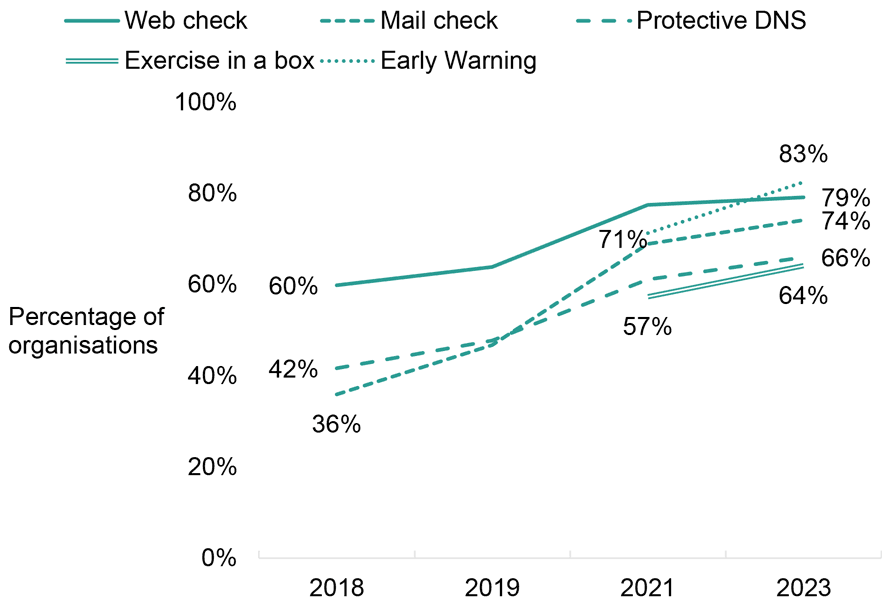
Source: SG CRU and NCSC
Cyber incident notification being used
The Scottish Public Sector Cyber Incident Notification Process encourages the voluntary reporting of cyber incidents to the Scottish Government, Police Scotland and NCSC in a consistent way. This policy helps coordinate a multi-agency response to significant cyber attacks affecting the Scottish public sector and ensures that all necessary resources and expertise can be swiftly deployed to assist organisations during an incident. The SC3 is now taking on the key coordination role for these notifications.
Figure 6 shows an increase in the reporting of incidents through the Notification Policy. Four incidents were reported in 2018 and 12 incidents in 2022. While the Scottish Government is not a reporting agency for cyber incidents, the increased number of notifications may illustrate the strong engagement and trusting relationships between SG CRU and the wider public sector in Scotland.
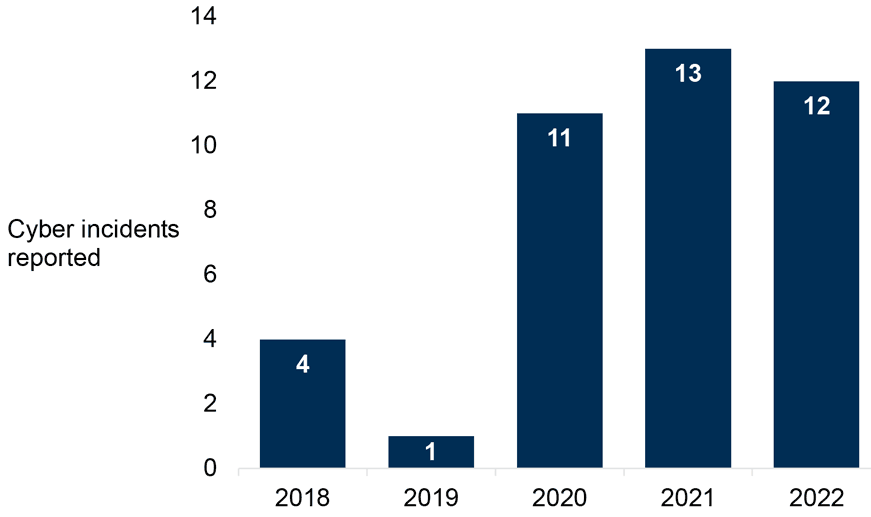
Source: SG CRU
Independent assurance of critical technical controls
Cyber assurance refers to the systematic evaluation of the security arrangements of an organisation’s information systems by measuring how well they conform to a set of established criteria. Scottish Ministers asked all public bodies to put in place arrangements for independent assurance in 2018. They specifically requested that organisations adopt Cyber Essentials (CE) or Cyber Essentials Plus (CE+).
Since then, the number of public sector organisations with CE has decreased slightly over time. In 2021, 47% of organisations had CE and 46% had CE+. In 2023, these percentages had fallen to 35% and 30% respectively as shown in Figure 7.
Possible reasons for the decrease include the significant changes to the Cyber Essentials requirements and assessments which have made the certification more challenging for large, complex organisations to achieve. In addition, some organisations have chosen to pursue other proportionate and risk-based assurance measures more appropriate to their needs, including the PSN Code of Connection.
SC3 has established a workstream to review the cyber assurance landscape across the public sector in Scotland, fully recognising the existing regulatory regimes and essential compliance standards that are already in place, such as the NIS Regulations and the PSN Code of Connection, and the emerging GovAssure process.
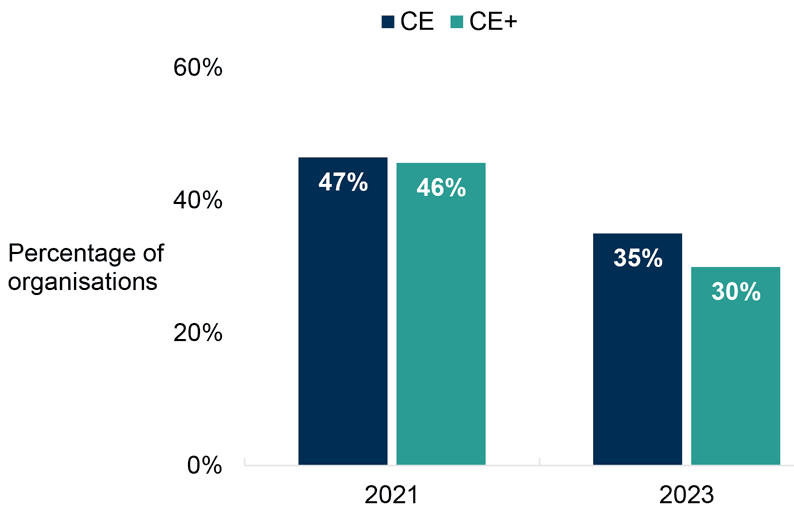
Source: SG CRU
Cyber assurance of the public sector’s supply chain
Most organisations rely on suppliers to deliver and provide products, systems, and services. An attack on suppliers can be just as damaging as one that directly targets an organisation. Supply chains can be long and complex, and effectively securing the supply chain can be challenging because vulnerabilities can be inherent, introduced or exploited at any point within the chain.
In 2023, 87% of Scottish public sector bodies reported having cyber assurance in place for their procurement processes. The SG CRU will continue to track progress in this area over time through further surveys and engagement.
Supply chain cyber security and resilience have been central to the Scottish Government’s own cyber posture and Scotland’s public sector is heavily dependent on the services and products of many SMEs, with more than 19,500 registered with the Supplier Development Programme.
Building on NCSC’s supply chain guidance, and to support the Scottish public sector through procurement processes, the SG CRU published supply chain guidance in 2020 and produced a decision-making support tool. The Cyber Security Procurement Support Tool has been providing a consistent approach for the sector to obtain cyber assurance from prospective suppliers as part of the procurement process. Since 2020, the tool has supported 852 organisations (public sector buyers and private/third sector suppliers) with over 1500 registered users. Further work is required to better understand the supply chain eco-system across the public sector.
Developing the cyber security profession in Scotland’s public sector
On behalf of the Scottish and UK governments, ScotlandIS delivered funding of £145,000 to upskill 85 cyber security professionals from 30 public sector organisations during autumn 2022. These organisations included 17 local authorities, 12 health boards and one other organisation delivering essential services.
Aligned with the UK Government, the Digital, Data and Technology (DDaT) Profession was introduced within the Scottish Government to attract and retain the talent required. In Scotland, the DDaT Profession includes an additional family of jobs with common definitions for Cyber Security and Information assurance roles and this lays the foundation for standardisation of roles and clearer career paths across the wider public sector.
Since autumn 2021, the Empowering Women to Lead Cyber Security in Scotland programme (run by Empowering You) has been supporting the professional development of women in cyber-related roles across the public, private and third sectors with creative, highly experiential workshops, individual coaching and a group-led challenge presentation. To September 2023, 107 women have graduated . Further cohorts will graduate in 2024.
Building cyber resilience awareness of the general workforce
Since 2017, with funding from the Scottish Government, Scottish Union Learning has worked with 24 unions and 132 organisations across both the public and private sectors to deliver cyber security and resilience training for employees engaging within 3,793 employees. In addition, Scottish Union Learning has trained 259 union learning representatives.
A toolkit for workers developed as part of the programme has been used over 2,500 times and the four video ‘lessons’ have been used 500 times. Workers do not have to be members of a union to participate in training.
Looking ahead: priorities for the public sector
For the foreseeable future, supporting the growth of the public sector’s cyber resilience maturity will remain a priority for the SG CRU team, with a particular focus on:
- Setting agreed targets for specific areas of the public sector and collaborating with our partners to deliver activity that will improve the rate of exercising, adoption of Active Cyber Defence measures, log retention policies and supply chain management.
- Developing and implementing a cyber assurance regime for the public sector to highlight gaps and make improvements in their cyber resilience. It will be necessary to better understand the supplier chain eco-system across the public sector and better identify cyber security gaps and needs.
- Supporting public sector bodies to identify the most appropriate standards with which to align and the cyber assurance mechanisms that verify them.
- Developing cyber security professional skills within the public sector, including supporting the work of the UK Cyber Security Council to raise professional standards.
- Strengthening the role of the Scottish Cyber Coordination Centre (SC3) to support the public sector with early warning, intelligence sharing, exercising and incident response coordination.
The cyber resilience of Scotland’s third sector
The Department for Science, Innovation and Technology’s (DSIT) Cyber Security Breaches Survey (2023) suggests that despite being more aware of the NCSC’s guidance than businesses, third sector organisations are less cyber resilient than businesses across the UK.
Almost a quarter of UK charities have identified a cyber breach in the past year. 31% of charities have board members or trustees with responsibility for cyber security, an increase from 26% recorded in the 2022 survey. However, there has been a decline in the percentage of charities that consider cyber security as a priority at a senior level. This has decreased from 72% to 62% over the previous year. This is a particular concern for low-income charities (under £100,000 in annual income) because they experienced an even bigger decrease from 67% to 53%.
Differing cyber resilience maturity across the third sector
With the relatively low cyber resilience maturity level in many parts of the third sector, the SG CRU commissioned an academic research project to look at the opportunities and challenges. It has provided recommendations which, together with the findings of a series of engagement sessions with the sector, will help inform the direction of future work.
Building cyber resilience within the Social Care sector
The Scottish Council for Voluntary Organisations (SCVO) has led the way in the third sector to raise awareness of the cyber risk, helping organisations understand their cyber maturity level, their risk levels and the steps they can take to manage these risks.
Two priorities were identified within the SG CRU’s third sector work programme (2021-23):
- Social care – due to the potentially severe impact of a cyber incident which could put lives at risk, and the sensitive nature of the data held.
- Housing – due to the housing sector’s overlap with the social care services and its notable funding responsibility.
Social care is delivered by organisations from all sectors and professional development for carers is provided not only by employers but also by the Scottish Social Services Council (SSSC). The SSSC is in its third year of engagement activity dedicated to growing the capacity of care providers, including in the third sector, to help their staff to be cyber resilient, and to improve the cyber resilience of service users, many of whom rely on digital technologies for accessing public services, but also for everyday activities like shopping and communication.
The SSSC has included cyber resilience as part of its online learning offer, which is freely available on their staying secure online webpage.
From August 2022 to July 2023, 78 third sector organisations took part in the facilitated Exercise in a Box sessions. The priority social care and housing organisations are included in future targets for the delivery of the Exercise in a Box.
Looking ahead: priorities for the third sector
The complex composition of the third sector in Scotland is posing a significant challenge in terms of understanding its cyber resilience capabilities and posture. The extensive range of sizes, sub-sectors, delivery mechanisms and causes they work towards also creates challenges in effectively using the right approach.
A 2023 research report Cyber resilience and the third sector – risks, challenges and opportunity: research report commissioned by the Scottish Government provided an analysis of the sector, its needs and attitudes towards cyber resilience. It also identified the following challenges:
- Lack of consistent advice, guidance and regulations in key areas of cyber resilience and security
- Low level of experience and knowledge of cyber security and resilience amongst Board members
- Unsuitable UK cyber certification requirements for some areas of the third sector
- Cyber security and resilience complex language and terminology
- Insufficient funding for cyber resilience development generally.
The Scottish Government and the CyberScotland Partnership will address these challenges and work closely with third sector national representative bodies, including SCVO as the lead organisation to establish the best support model to improve cyber resilience across this sector.
The cyber resilience of Scotland’s private sector
DSIT’s Cyber Security Breaches Survey 2023 shows that:
- 32% of businesses reported a cyber incident, which was slightly fewer than in the previous two years.
- Around one third of the businesses surveyed had board members accountable for cyber security as part of their role.
- The finance and insurance, health and social care, and the information and communications sectors generally have better cyber security and resilience postures than other sectors.
Risk awareness
Scotland is a nation of small and medium-sized enterprises (SMEs), with SME’s employees accounting for 44 per cent of total Scottish employment and 38 per cent of turnover, according to the Small Business Survey Scotland (2021). The survey also found that smaller businesses invest less in cyber security and resilience measures.
As part of the Private Sector Action Plan, a range of events and training have been offered to the private sector in Scotland. These have included Exercise in a Box training to 276 businesses (between April 2021 and June 2022), Executive Cyber Education to senior leaders (2021-22) and ongoing support to companies through the Internet of Things (IoT) Secure Services initiative encouraging a secure by design approach to the development of IoT (in 2022-23). The Scottish Government also funded the Cyber and Fraud Centre Scotland to operate a free helpline for the SME community and the third sector to help victims of cyber crime understand what support is immediately available to them and assist them with recovery. Since April 2021, it has supported 134 organisations (including 97 private sector businesses) in Scotland.
Cyber Essentials
In 2015, the Cyber Resilience Strategy for Scotland positioned the Cyber Essentials scheme as an important baseline standard of security, protecting organisations against the most common, non-targeted cyber attacks.
IASME is the NCSC-nominated authority for managing the Cyber Essentials scheme. Both IASME and the NCSC are key stakeholders in the Cyber Scotland Partnership supporting the collaborative approach to securing a cyber resilient Scotland.
The rapid adoption of Cyber Essentials (CE) and Cyber Essentials Plus (CE+) among all Scottish organisations is demonstrated in Figure 8. The number of CE certifications increased from 1 in 2016 to 1,384 in 2022. The number of CE+ certifications increased from 3 to 380 over the same period.[8]
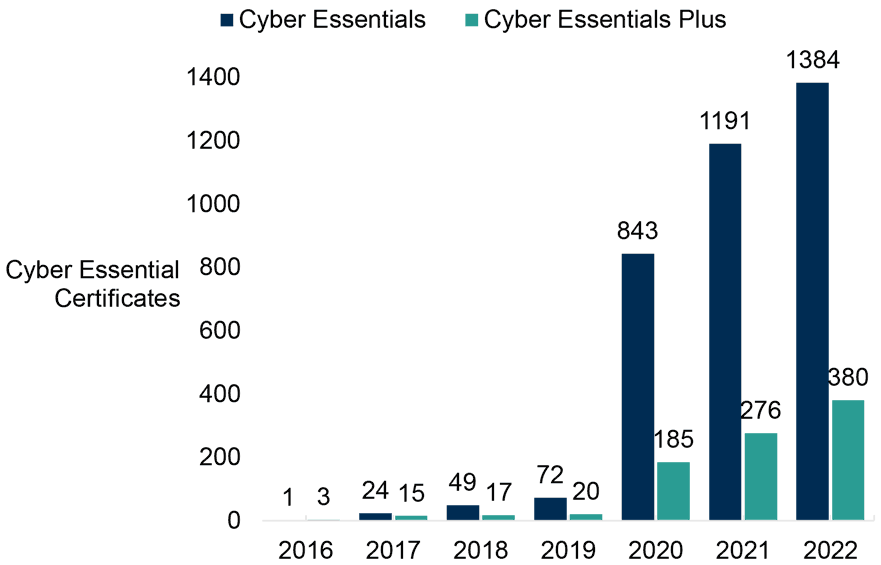
Source: IASME
Key Influencers / IT Managed Service Providers (ITMS)
In 2021, 40% of businesses in the UK used an IT Managed Service Provider (ITMS), and in the Cyber Breaches Survey it was found that the cyber security aspect was not an important consideration to businesses when selecting a Managed Service Provider (MSP).[9] Many businesses assumed that the ITMS also looked after the cyber security for their company, which in the case of some suppliers was a misconception.
Since then, the SG CRU has worked with ScotlandIS to map out both the Cyber Security and IT Managed Service Providers in Scotland. Two searchable directories are now available online of Scottish cyber security companies and IT Managed Services.
This work identified that many of the ITMS providers were themselves small businesses, looking after the interests of predominantly other small businesses. Half of them appeared to lack any cyber security certification. ScotlandIS engaged with the ITMS and 47 organisations have gained Cyber Essentials or Cyber Essentials Plus certification so far, thus improving understanding of risk and client expectations around incident response.
Recognising ITMS’ role as a critical touchpoint for cyber security to small and micro businesses, ScotlandIS further engaged with the ITMS to bring them together as a network of organisations to facilitate knowledge and share expertise, with the aim of improving the cyber security of their clients.
DigitalBoost Development Grant
The Business Gateway DigitalBoost Grant distributed Scottish Government funding to businesses and organisations to help them use digital technologies and enhance workforce skills.
With the SG CRU’s efforts, a condition of the grant allowed the successful applicant to undergo a cyber health check in the form of a Cyber Essentials Pre-Assessment.
Since 2021, at least 3,320 businesses have undergone the Cyber Health Check placing them in a better position to understand the cyber threat and risk to their business and pointing them to mitigations available to reduce this risk.
Looking ahead: priorities for supporting the cyber maturity growth of the private sector
Scotland’s business landscape consists of almost 360,000 small and medium enterprises, and they account for over 99% of all private sector businesses[10]. Engaging with them all effectively remains a challenge and it will be necessary to target those business areas most at risk of a cyber attack, or most vulnerable if subject to an attack. Utilising business representative bodies/touchpoint will also be useful routes to businesses.
Whilst policy interventions proved effective at some key points for pockets of the private sector, they have not been yet performed at a scale that could significantly improve the businesses’ understanding of risk, their organisational security or preparedness at the national level.
More collaboration between the public and private sectors is required. Areas of focus will include:
- Through SC3, building collaboration and sharing threat intelligence and solutions through private and public partnership
- Promoting the secure by design approach to our industries, and in business use of technology
- Closing the skills gap and engendering a cyber resilient culture across Scottish businesses.
- Working with business representative bodies to extend reach to businesses.
Building the cyber security industry in Scotland, and growing the skills and the talent pipeline
The Scottish cyber security products and services industry is growing steadily, and the number of active cyber security offices reached 400 in 2023, as shown in Figure 9.
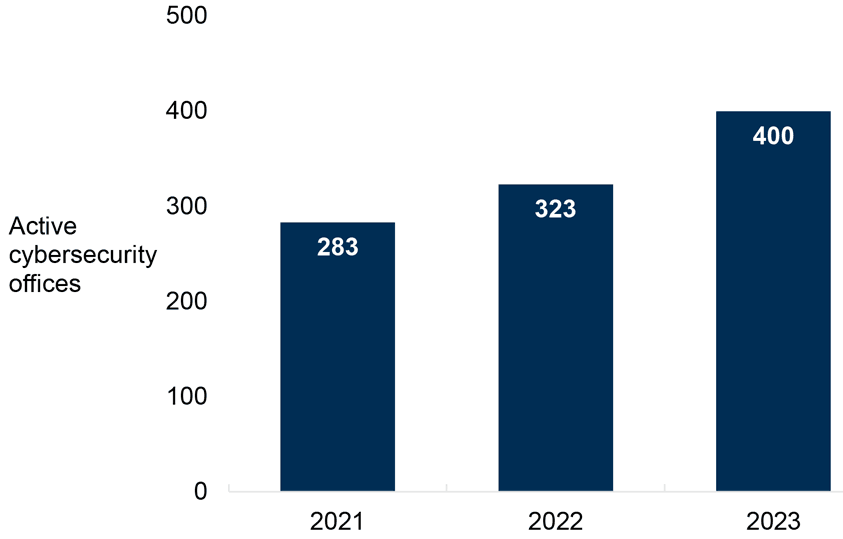
Source: Cyber Security Sectoral Analysis 2023
Scotland maintains its position within the growth of the wider UK cyber security sector:
- In 2022, Scotland was home to 8% of the active UK cyber security offices and hosted approximately 7% of all the UK-based cyber security employment – the same as in 2021[11].
- Scotland had 2,338 core cyber security job vacancies in 2022
- Scotland had the third highest percentage (13%) of all UK core cyber security job vacancies in 2022[12] out of twelve UK regions. In 2021 this figure was 5.3%[13].
- The mean salary offer for these vacancies has dropped from £56,800 in 2021 to £54,500 in 2022, which may be accounted for by the economic climate.
The maturity of Scotland’s cyber security education ecosystem
In 2022, the NCSC assessed the maturity of the cyber security education ecosystems of a number of areas in the UK, including Scotland. Scotland was classified as “dynamic” in twelve areas including:
- our key educational establishments
- our certified degrees
- our cyber security cluster
- our careers network
- our numbers of Higher and Advanced Higher Computer Science pupils and the growth in the number of female students for these awards (though it is acknowledged that numbers are still low).
NCSC’s report identified areas for continued improvement, including in relation to the numbers of students studying for Higher National Certificates and Diplomas in colleges, and the numbers of female students at all levels.
Skills shortage
As with most countries, the cyber security industry in Scotland and the rest of the UK faces skills shortages to meet the increasing demand. According to the 2023 Cyber Security Skills in the UK Labour Market survey[14], 44% of employers in the cyber sector said that the job applicants they have seen lacked technical cyber security skills.
The 2023 survey (which refers to the labour market in 2022) found that:
- An average of 5,921 core cyber roles were advertised each month in the UK. 7% of these were located in Scotland[15], which is an increase from 5.3% in 2021.
- There were an estimated 7,000 new entrants into the UK cyber security workforce, with 4,700 estimated to have left the sector.
- There was an estimated shortfall in personnel in the cyber security sector of around 11,200 people in 2022. This is a decrease from 2021 where the shortfall was an estimated 14,100.
- There is still a low number of the workforce coming from diverse backgrounds.
In response to the continuing skills shortage, the Scottish Government has set out key actions relating to skills development in its Learning and Skills Action Plan and works with Skills Development Scotland, Education Scotland, the NCSC, Scotland’s colleges and universities, the Abertay cyberQuarter and other partners to strengthen the skills pipeline and meet demand.
Development of cyber security professionals
The cyber security profession is relatively young and with the increasing demand for cyber security professionals, many people occupying cyber security roles lack qualifications or professional certification, having developed their knowledge and skills while in the role and over a number of years on the job.
DSIT’s Cyber Security Skills in the UK Labour Market 2022 report shows that 39% of employers specified in their vacancy adverts that they expected candidates to hold a Certified Information Systems Security Professional (CISSP) certification. This request was an increase from 36% in the previous year, and the demand for other certifications is also increasingly common.
The UK Cyber Security Council is the self-regulatory body for the UK's cyber security profession. It is responsible for agreeing and putting in place nationally recognised standards for cyber security. The Scottish Government hosted a roundtable for the Council’s leaders to meet Scottish stakeholders in October 2022, following which the Council was invited to become the seventeenth partner in the CyberScotland Partnership, where it will be well placed to work with partners to embed standards in Scotland.
To formalise the skills of professionals working in the sector, ScotlandIS have managed upskilling funding on behalf of the Scottish Government. Since 2021, it has provided 335 cyber security staff across 103 Scottish organisations in all sectors with financial support to enable them to undertake a variety of certifications, and we note there is a clear appetite for further similar opportunities.
Talent attraction - careers awareness, creating opportunity and promoting diversity.
Awareness of cyber security careers – especially of the plethora of rewarding roles available and how to get into a role – remains low. Gender balance is still an issue with women accounting for 23% of the workforce in digital technology roles.[16]
Greater diversity in the workforce means that problem solving can be richer and more creative and it is a practical step towards filling the skills gap. We are not attracting enough people from diverse backgrounds into the cyber security profession, and we are not seeing career progression with these groups. Boards and senior management in particular tend to lack diverse background representation. The Scottish Government has taken steps to address this by funding activity that promotes cyber careers to people living in disadvantaged communities, supporting neurodivergent people through training, and offering mentoring to women to become confident leaders, and they see this a priority going forward.
The CyberScotland Partnership has been working hard to inspire young people and career changers, and to promote pathways into careers. It will continue to focus on reaching people who face barriers, not only to feel confident to begin training in cyber security and to enter the profession, but to progress once they are in work.
Skills Development Scotland has led cyber careers awareness through their Digital World website[17], where it hosts information about roles in the profession and provides information about where to find courses and undertake qualifications. Since 2017 it has delivered 33 online “Live Lessons” on several topics relating to cyber security, aimed at 12- to 14-year-olds, and has reached nearly 20,000 pupils. And their online independent lessons have been accessed 372,361 times since 2017. SDS is also coordinating industry engagement in education through its Tech Education in the Classroom programme, which brings together employers and equips them to support young people’s skill development and aspiration. This programme seeks to link and maximise the impact of existing programmes, including STEM Ambassadors and ScotlandIS’s Critical Friends programme.
YouthLink Scotland, the national youth work agency, has been working to embed cyber resilience and awareness of cyber security careers into youth work programmes, and Young Scot has showcased careers in the cyber industry to young people directly through its DigiKnow? information campaign and on social media.
A creative and innovative programme by Civic Digits CIC theatre company has included interactive performances of The Big Data Show that has, to date, reached more than 3,000 students from P7 to S3. 830 students have received an award in “An Introduction to Basic Cyber Resilience and Digital Citizenship” at SCQF level 3. Civic Digits are now working with the cyberQuarter and industry partners to deliver immersive one day experiences at the cyberQuarter for P7 children from Dundee.
CyberFirst in Scotland
In March 2023, Education Scotland signed a Memorandum of Understanding with the NCSC to be the CyberFirst partner for Scotland, with the aim of growing the programme in Scotland and improving schools’ and colleges’ capacity to deliver high quality cyber security learning and teaching. A pilot saw seven schools recognised as CyberFirst schools. The CyberFirst Girls Competition, which seeks to inspire girls to consider training and careers in cyber security, has grown in popularity in Scotland, with 65 schools taking part in 2023 (up from 29 in 2022).
Qualifications and vocational training
Scotland has developed a comprehensive and coherent framework of cyber security qualifications from school-age to PhD, and numbers of learners have been increasing..
SCQF Level 12 |
PhDs |
||
Level 11 |
Masters Degrees |
Graduate Apprenticeship in Cyber Security (Masters) |
|
Level 10 |
Honours Degrees |
Graduate Apprenticeship in Cyber Security (Honours) |
PDA in Cyber Resilience |
Level 9 |
PDA in Cyber Resilience |
||
Level 8 |
SQA Higher National Diploma (HND) |
Modern Apprenticeship in Information Security |
|
Level 7 |
SQA Higher National Certificate (HNC) |
PDA in Cyber Resilience |
|
Level 6 |
SQA National Progression Award in Cyber Security |
Modern Apprenticeship in Information Security |
|
Level 5 |
SQA National Progression Award in Cyber Security |
||
Level 4 |
SQA National Progression Award in Cyber Security |
SQA Cyber Security Fundamentals Unit |
SQA Internet Safety Unit |
National Progression Awards in Cyber Security
The SQA’s National Progression Awards (NPA) in Cyber Security were launched in 2015. They are available at Scottish Credit and Qualifications Framework (SCQF) levels 4, 5 and 6 and are delivered in schools and colleges. More than 100 of Scotland’s secondary schools deliver the NPAs, of which the most popular is the level 5 qualification.
By the academic year 2022/23, 5,348 pupils had taken an NPA in cyber security, with numbers of entries increasing year on year, with a lull caused by the pandemic. Numbers of female students remain low, but they are increasing year on year. 19 colleges deliver the NPAs, with the level 5 again being the most popular. By the academic year 2021-22, 3,018 students had taken an NPA in college. These trends are highlighted in figure 10.

The numbers of National Progression Awards in Cyber security in schools in Scotland increased from 50 in the 2015/16 academic year to 1,085 in the 2021/22 academic year, then dropped to 746 the next year and increased to 982 in 2022/23. For colleges, this number increased from 31 in 2015/16 to 617 in 2019/20 and fell to 295 in 2021/22.
Source: Scottish Qualification Authority
Gender disparities
Figure 11 shows the numbers of students taking an NPA in cyber security at SQA levels 4, 5 and 6, from the 2015/16 academic year to the 2022/23 academic year. Numbers have increased year on year, except in 2021/2022 when the COVID-19 pandemic caused some students to defer their studies. There is a large gap between female and male students. In 2022/23 there were 1,521 male students and 264 female students in these courses.

The numbers of female students taking National Progression Awards in cyber security in Scotland has increased overall from 12 in 2015/16 to 264 in 2022/23. However, there are many more males taking these qualifications, with 1521 males taking a NPA in cyber security in 2022/23.
Source: Scottish Qualification Authority
The proportion of female students has remained low over time, and in total only 14.4% (1,273) of all those achieving the award (8,859) over time were female.
Higher National qualifications
Eleven colleges deliver Higher National (HN) qualifications in cyber security. These are available at Certificate (SCQF level 7) and Diploma (SCQF level 8). Some colleges have “articulation” agreements in place with universities, whereby students can use their HNC or D to move directly into the second or third year of a degree programme. Since its launch in 2018, 1,317 students have studied for the HN Certificate. Since its launch in 2019, 738 students have studied for the HN Diploma. These trends are highlighted in figure 12.

The number of Higher National Qualifications in Scotland reached a peal pf 366 in the 2018/19 academic year and fell to 251 in the 2020/21 academic year. The number of Higher National Diplomas in Cyber Security reached a peak of 250 in the 2019/20 academic year and fell to 220 in the 2020/21 academic year.
Source: Scottish Qualification Authority
Degrees
Thirteen universities offer degrees in cyber security, or degrees in computing that include modules on cyber security. The number of undergraduates increased from 5,265 in 2019/20 to 5,745 in 2020/21. The number of postgraduates increased from 1,500 in 2019/20 to 2,050 in 2020/21.
Graduate Apprenticeships
Honours-level Graduate Apprenticeships are offered by three universities, with Masters-level offered by a further three. Between its launch in 2017 and the 2021/22 academic year, 195 students had enrolled in an honours-level apprenticeship. Between its launch in 2018 and the 2021/22 academic year, 177 students had enrolled in a Masters course.
Places are heavily skewed towards male students, with the percentage of male students consistently over 80% each year to date.
Looking ahead: priorities for the cyber security sector and for skills
- The Scottish Government will continue to work with partners to boost upskilling activity, to enable cyber security professionals, especially in the public sector, to gain new skills and certification.
- The Scottish Government and its partners will work together to increase our efforts to promote diversity, working with multiple partners to deliver the inaugural cyber-related diversity summit in autumn 2023. This will be followed by an action plan focused on empowering people who face barriers to entry or progression in cyber careers.
- The CyberScotland Partnership will continue to encourage the cyber industry to support cyber security learning in schools, colleges and universities.
- The Scottish Government and its academic and education partners will encourage continued growth of cyber security courses in further and higher education as well as embedding cyber security and resilience within other academic disciplines.
We want to equip teachers and parents of the youngest children with high quality resources to ensure children learn the fundamentals of cyber security. The Scottish Government and Education Scotland are launching The Bongles and the Crafty Crows, a storybook for first-year primary school children, which focuses on learning outcomes relating to security, passwords and passcodes. It will be distributed to all 54,500 Primary 1 children in November 2023, in time for Scottish Book Week and will have associated learning and teaching materials available for teachers. NCSC have endorsed the book.
Next steps
The Scottish Government and its partners will continue to work together to realise Ministers’ vision of Scotland thriving as a digitally secure and resilient nation. Refreshed action plans will be published in the Autumn of 2023 to build on progress made so far and to continue our work towards a safe, secure and resilient future for Scotland.
Contact
Email: CyberResilience@gov.scot
There is a problem
Thanks for your feedback